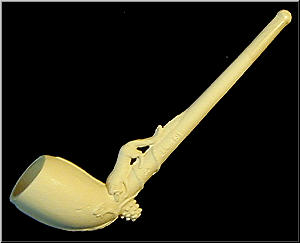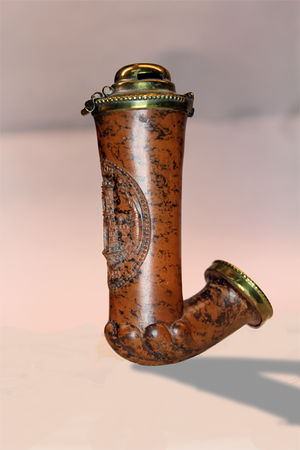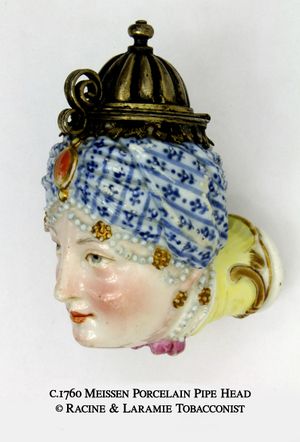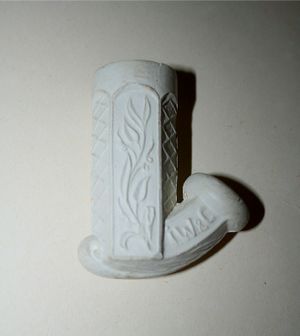Clay: Difference between revisions
No edit summary |
mNo edit summary |
||
| (21 intermediate revisions by 2 users not shown) | |||
| Line 1: | Line 1: | ||
[[Image:pollockclaypipes1.jpg|thumb | [[Image:pollockclaypipes1.jpg|thumb|Fox & Grapes, [[Pollock Clay Pipes]]]] | ||
The topic of [[clay]] pipes is very extensive. Therefore here only in a nutshell: clay in this case is almost always a very fine white clay. | |||
Low-quality "clay" pipes are actually made from [[porcelain]] forming techniques known as slip, and poured into a mold. | |||
These are porous, of very low quality, and impart unwanted flavors to a smoke. | |||
Top-notch clays, on the other hand are made in a labor-intensive process that requires beating all air out of the clay, hand-rolling each pipe before molding it, piercing with a fine wire, and careful firing. | |||
Traditionally, clay pipes are unglazed. | |||
Clays burn "hot" in comparison to other types of pipes, so they are often difficult for most pipe-smokers to use. Their proponents claim that, unlike other materials, a well-made clay pipe gives a "pure" smoke, with no flavor addition from the pipe bowl. In addition to aficionados, reproductions of historical clay styles are used by some Historical re-enactors. | Clays burn "hot" in comparison to other types of pipes, so they are often difficult for most pipe-smokers to use. | ||
Their proponents claim that, unlike other materials, a well-made clay pipe gives a "pure" smoke, with no flavor addition from the pipe bowl. | |||
In addition to aficionados, reproductions of historical clay styles are used by some Historical re-enactors. | |||
Clay pipes were once considered disposable items and the large quantities discarded in the past are often used as an aid in dating by industrial archaeologists. | Clay pipes were once considered disposable items and the large quantities discarded in the past are often used as an aid in dating by industrial archaeologists. | ||
<noinclude> | |||
<div style="clear:both"></div> | |||
== Links == | |||
* [[Tobacco Pipe Manufacturers and Distributors Found in U.S. Directories in the Library of Congress]], Compiled by Paul Jung in 1991 | |||
* | * Heather Coleman, [[A Short History Of Clay Pipes]] for additional information | ||
* | * Heather Coleman, [http://www.dawnmist.org/pipdex.htm Almost everything you could wish to know about Clay Tobacco Pipes] | ||
* Ivor Noël Hume, [https://www.slaveryandremembrance.org/Foundation/journal/Winter03-04/pipes.cfm Hunting for a Little Ladle, Tobacco Pipes] excellent article from the Colonial Williamsburg Journal | |||
* | * [https://www.heritage.nf.ca/articles/exploration/pipemarks-introduction.php 17th and 18th Century Marked Clay Tobacco Pipes From Ferryland, NL] useful website for identifying clay pipe makers marks | ||
* Rebecca C. W. Robinson, [https://www.ascsa.edu.gr/uploads/media/hesperia/147907.pdf Tobacco pipes of Corinth and of the Athenian Agora] | |||
<div style="clear:both"></div> | <div style="clear:both"></div> | ||
| Line 20: | Line 31: | ||
* [[Bell]] William and David Bell; 19th century clay pipe factory in Quebec | * [[Bell]] William and David Bell; 19th century clay pipe factory in Quebec | ||
* [[Henderson & Lovelace, E.M.]] second half of the 19th century clay pipe factory in Montreal | * [[Henderson & Lovelace, E.M.]] second half of the 19th century clay pipe factory in Montreal | ||
* [[ | * [[Olde World Fine Clays]] Stephen Bray | ||
<div style="clear:both"></div> | <div style="clear:both"></div> | ||
| Line 32: | Line 43: | ||
== English clay pipes == | == English clay pipes == | ||
[[Image:pollockclaypipes1.jpg|thumb|Fox & Grapes, [[Pollock Clay Pipes]]]] | |||
=== Manufacturers === | === Manufacturers === | ||
| Line 46: | Line 56: | ||
=== Links === | === Links === | ||
* [http://www.pipearchive.co.uk/pdfs/howto/makers/LIVNP_2012_03_02_OSWALD.pdf Clay pipe makers list] as published by Adrian Oswald in 1975 | * [http://www.pipearchive.co.uk/pdfs/howto/makers/LIVNP_2012_03_02_OSWALD.pdf Clay pipe makers list] as published by Adrian Oswald in 1975 | ||
* [http://etheses.dur.ac.uk/6882/1/6882_4187.PDF?UkUDh:CyT Tobacco pipes, pipemakers, and tobacconists in Newcastle and Gateshead until c1800: an archaeological study] master thesis | * Lloyd J. Edwards, [http://etheses.dur.ac.uk/6882/1/6882_4187.PDF?UkUDh:CyT Tobacco pipes, pipemakers, and tobacconists in Newcastle and Gateshead until c1800: an archaeological study] master thesis | ||
* S. Newns, [https://doi.org/10.11141/ia.45.3.4 The Clay Tobacco Pipes] in N. Corcos et al. Excavations in 2014 at Wade Street, Bristol - a documentary and archaeological analysis, Internet Archaeology 45. | |||
<div style="clear:both"></div> | <div style="clear:both"></div> | ||
| Line 63: | Line 74: | ||
== German clay pipes == | == German clay pipes == | ||
[[Image:Jwc1.jpg|thumb|[[Wiener Kaffeehauspfeife]] by [[J. W. & C.]], courtesy Heinz Brayer Dieken Merenberg Westerwald]] | |||
=== Manufacturers === | === Manufacturers === | ||
* [[Lothar Hein]] clay pipe maker | * [[Lothar Hein]] clay pipe maker in [[Centers of pipe production in Germany#Kannenbäckerland / Westerwald|Hilgert]] | ||
* [[Jens Steuler]] clay pipe maker | * [[Müllenbach & Thewald]] clay pipe factory in [[Centers of pipe production in Germany#Kannenbäckerland / Westerwald|Höhr]] | ||
* [[J. Schilz-Mühlenbach]] clay pipe factory in [[Centers of pipe production in Germany#Kannenbäckerland / Westerwald|Höhr]] | |||
* [[Jens Steuler]] clay pipe maker in [[Centers of pipe production in Germany#Kannenbäckerland / Westerwald|Hilgert]] | |||
* [[J. W. & C.]] clay pipe factory in [[Centers of pipe production in Germany#Kannenbäckerland / Westerwald|Höhr]] | |||
=== Links === | |||
* [http://helene-bonn.info/AK/einen.htm KnasterKOPF – A specialist periodical dealing with the history of clay pipes and tobacco] | |||
* [http://helene-bonn.info/AK/enaein.htm German Society for Clay-Pipe Research] | |||
* Natascha Mehler, [https://doi.org/10.1007/s41636-018-0108-9 Clay Tobacco-Pipe Research and Historical Archaeology in Germany, a Difficult Relationship], Hist Arch 52, 454–466 (2018). | |||
<div style="clear:both"></div> | <div style="clear:both"></div> | ||
== Hungarian clay pipes == | == Hungarian clay pipes == | ||
[[ | [[Image:Selmec.jpg|thumb|Selmec Clay, courtesy Geoffrey Mogilner, [http://www.racineandlaramie.com/ Racine & Laramie Tobacconist]]] | ||
The illustration (to the right) is a 19th century example with the seal of the town of [[Selmec]] on the front. The seal represents two salamanders which legend tells us led residences to the gold deposits. Hammer and pick are also represented. These clays represent an entirely different clay pipe tradition from the English clay pipes. These shapes are based on Turkish clay pipes which entered Europe from the East. | The illustration (to the right) is a 19th century example with the seal of the town of [[Selmec]] on the front. The seal represents two salamanders which legend tells us led residences to the gold deposits. Hammer and pick are also represented. These clays represent an entirely different clay pipe tradition from the English clay pipes. These shapes are based on Turkish clay pipes which entered Europe from the East. | ||
| Line 102: | Line 122: | ||
=== Manufacturers === | === Manufacturers === | ||
* [[Creu Retinyola]] clay pipe factory in Palafrugell (Catalonia) | * [[Creu Retinyola]] clay pipe factory in Palafrugell (Catalonia) | ||
* [[ | * [[Esteve Espinet]] clay pipe factory in the Palamos area (Catalonia) | ||
* [[Juan Castellà]] 17th - 19th century clay pipe factory in the Palamos area (Catalonia) | * [[Juan Castellà]] 17th - 19th century clay pipe factory in the Palamos area (Catalonia) | ||
| Line 110: | Line 130: | ||
=== Manufacturers === | === Manufacturers === | ||
[[ | * [[Olaf Forsberg]] 18th century clay pipe maker | ||
<div style="clear:both"></div> | <div style="clear:both"></div> | ||
| Line 120: | Line 140: | ||
* [[Robert Bannerman]] clay pipe factory (1875-84), located in New York state, USA | * [[Robert Bannerman]] clay pipe factory (1875-84), located in New York state, USA | ||
== Links == | |||
* [https://books.google.de/books?id=6Nw0ThZ0m-EC Clay Tobacco Pipes and the Fur Trade of the Pacific Northwest and Northern Plains] | |||
<div style="clear:both"></div> | <div style="clear:both"></div> | ||
== Porcelain pipes == | == Porcelain pipes == | ||
{{Main|Porcelain}} | |||
{{:Porcelain}} | |||
<div style="clear:both"></div> | |||
< | == Trivia == | ||
=== Public pipes === | |||
<blockquote><q>"Pub Pipes", the long stemmed clay pipes, were essentially public pipes used in pubs (public houses) that were given to patrons to use. After a patron used it, the tip (and I dont know how much of the tip this would be) was broken off so the next person could use it. This way, you werent smoking someone elses spittle along with the tobacco. I dont know if this was due to health concern (although I am sure it helped to prevent spread of germs) or just because it may seem gross to put a pipe in your own mouth after having been in someone elses.</q><ref>Posted by an unknown author on [[Talk:Materials_and_Construction]].</ref></blockquote> | |||
It is unclear if this is just a myth or a hard fact but Ivor Noël Hume says: | |||
<blockquote><q>There are thousands of pipe fragments found in Williamsburg. An early explanation for their ubiquity had it that in colonial-era taverns pipes passed from mouth to mouth, but that in the interests of hygiene the previously lip-gripped section was broken off and thrown away. There is no documentary support for that notion, but it is known that used pipes were placed in iron cradles and heat cleansed in bake ovens before being issued to the next round of smokers.</q><ref>[https://www.slaveryandremembrance.org/Foundation/journal/Winter03-04/pipes.cfm Hunting for a Little Ladle, Tobacco Pipes] by Ivor Noël Hume</ref></blockquote> | |||
On the other hand the author of the [[Keens Steakhouse]] Website states: | |||
<blockquote><q>The tradition of checking one's pipe at the inn had its origins in 17th century Merrie Old England where travelers kept their clay at their favorite inn - the thin stemmed pipe being too fragile to be carried in purse or saddlebag.</q></blockquote> | |||
== References == | == References == | ||
| Line 133: | Line 167: | ||
__NOTOC__ | __NOTOC__ | ||
</noinclude> | |||
Latest revision as of 20:45, 28 December 2022

The topic of clay pipes is very extensive. Therefore here only in a nutshell: clay in this case is almost always a very fine white clay. Low-quality "clay" pipes are actually made from porcelain forming techniques known as slip, and poured into a mold. These are porous, of very low quality, and impart unwanted flavors to a smoke. Top-notch clays, on the other hand are made in a labor-intensive process that requires beating all air out of the clay, hand-rolling each pipe before molding it, piercing with a fine wire, and careful firing. Traditionally, clay pipes are unglazed.
Clays burn "hot" in comparison to other types of pipes, so they are often difficult for most pipe-smokers to use. Their proponents claim that, unlike other materials, a well-made clay pipe gives a "pure" smoke, with no flavor addition from the pipe bowl. In addition to aficionados, reproductions of historical clay styles are used by some Historical re-enactors.
Clay pipes were once considered disposable items and the large quantities discarded in the past are often used as an aid in dating by industrial archaeologists.
Links
- Tobacco Pipe Manufacturers and Distributors Found in U.S. Directories in the Library of Congress, Compiled by Paul Jung in 1991
- Heather Coleman, A Short History Of Clay Pipes for additional information
- Heather Coleman, Almost everything you could wish to know about Clay Tobacco Pipes
- Ivor Noël Hume, Hunting for a Little Ladle, Tobacco Pipes excellent article from the Colonial Williamsburg Journal
- 17th and 18th Century Marked Clay Tobacco Pipes From Ferryland, NL useful website for identifying clay pipe makers marks
- Rebecca C. W. Robinson, Tobacco pipes of Corinth and of the Athenian Agora
Canadian clay pipes
Manufacturers
- Bell William and David Bell; 19th century clay pipe factory in Quebec
- Henderson & Lovelace, E.M. second half of the 19th century clay pipe factory in Montreal
- Olde World Fine Clays Stephen Bray
Dutch clay pipes
Manufacturers
English clay pipes

Manufacturers
- Eric G. Ayto, clay pipe maker. Started in 1972 and now retired.
- Braesley Salop Clays early clay pipe factory, England, founded 1619
- Broseley Clay Tobacco Pipes Rex M. Key; Broseley, Shropshire
- David Cooper David J. Cooper, clay pipe maker
- Heather Coleman
- John Armstrong & Sons
- Pollock Clay Pipes
Links
- Clay pipe makers list as published by Adrian Oswald in 1975
- Lloyd J. Edwards, Tobacco pipes, pipemakers, and tobacconists in Newcastle and Gateshead until c1800: an archaeological study master thesis
- S. Newns, The Clay Tobacco Pipes in N. Corcos et al. Excavations in 2014 at Wade Street, Bristol - a documentary and archaeological analysis, Internet Archaeology 45.
Frensh clay pipes
Manufacturers
- Au Narghileh clay pipes by Laville in Montlucon
- Alphonse Hippolyte Bonnaud clay pipe maker 1824 until WWII, Marseilles area
- Crètal-Gallard old clay pipe company in Rennes
- Dutel-Giscolon 19th century clay pipes made in Montereau
- Jean Gambier
- Gravée 19th century clay pipe maker
German clay pipes
Manufacturers
- Lothar Hein clay pipe maker in Hilgert
- Müllenbach & Thewald clay pipe factory in Höhr
- J. Schilz-Mühlenbach clay pipe factory in Höhr
- Jens Steuler clay pipe maker in Hilgert
- J. W. & C. clay pipe factory in Höhr
Links
- KnasterKOPF – A specialist periodical dealing with the history of clay pipes and tobacco
- German Society for Clay-Pipe Research
- Natascha Mehler, Clay Tobacco-Pipe Research and Historical Archaeology in Germany, a Difficult Relationship, Hist Arch 52, 454–466 (2018).
Hungarian clay pipes

The illustration (to the right) is a 19th century example with the seal of the town of Selmec on the front. The seal represents two salamanders which legend tells us led residences to the gold deposits. Hammer and pick are also represented. These clays represent an entirely different clay pipe tradition from the English clay pipes. These shapes are based on Turkish clay pipes which entered Europe from the East.
Irish clay pipes
Manufacturers
Polish clay pipes
Manufacturers
Russian clay pipes
Manufacturers
- Vladimir Ershov clay pipes in Asia Minor tradition
Spanish clay pipes
Manufacturers
- Creu Retinyola clay pipe factory in Palafrugell (Catalonia)
- Esteve Espinet clay pipe factory in the Palamos area (Catalonia)
- Juan Castellà 17th - 19th century clay pipe factory in the Palamos area (Catalonia)
Swedish clay pipes
Manufacturers
- Olaf Forsberg 18th century clay pipe maker
US clay pipes
Manufacturers
- LePeltier (US)
- Robert Bannerman clay pipe factory (1875-84), located in New York state, USA
Links
Porcelain pipes
→ Main article: Porcelain

The first type of porcelain produced by Johann Friedrich Böttger was a refined and extremely hard red stoneware known in Germany as Böttgersteinzeug. It retained very crisp definition in its cast and on applied details. The Böttgersteinzeug could be polished to a gloss before firing. Models were derived from Baroque silver shapes and Chinese ceramic examples. Meissen's production of a hard paste white porcelain that could be glazed and painted soon followed, and wares were put on the market in 1713. Multicolour enamelled painting was introduced by Johann Gregorius Höroldt in 1723, with an increasingly broad palette of colors that marked the beginning of the classic phase of Meissen Porcelain.
See Meissen Porcelain for additional information on Porcelain pipes.
Trivia
Public pipes
"Pub Pipes", the long stemmed clay pipes, were essentially public pipes used in pubs (public houses) that were given to patrons to use. After a patron used it, the tip (and I dont know how much of the tip this would be) was broken off so the next person could use it. This way, you werent smoking someone elses spittle along with the tobacco. I dont know if this was due to health concern (although I am sure it helped to prevent spread of germs) or just because it may seem gross to put a pipe in your own mouth after having been in someone elses.[1]
It is unclear if this is just a myth or a hard fact but Ivor Noël Hume says:
There are thousands of pipe fragments found in Williamsburg. An early explanation for their ubiquity had it that in colonial-era taverns pipes passed from mouth to mouth, but that in the interests of hygiene the previously lip-gripped section was broken off and thrown away. There is no documentary support for that notion, but it is known that used pipes were placed in iron cradles and heat cleansed in bake ovens before being issued to the next round of smokers.[2]
On the other hand the author of the Keens Steakhouse Website states:
The tradition of checking one's pipe at the inn had its origins in 17th century Merrie Old England where travelers kept their clay at their favorite inn - the thin stemmed pipe being too fragile to be carried in purse or saddlebag.
References
- ↑ Posted by an unknown author on Talk:Materials_and_Construction.
- ↑ Hunting for a Little Ladle, Tobacco Pipes by Ivor Noël Hume
